Exciting! Scientists teach a MUSHROOM to crawl by giving it cute robotic legs and harnessing its natural electrical signals
Mushrooms can do some impressive things, from breaking down toxins to changing the inner workings of the human mind.
But now researchers have taken the fungi’s amazing skills to a new level by teaching them to crawl inside a robotic body.
Scientists at Cornwell University in New York have developed a new type of ‘biohybrid robot’ that puts the humble mushroom in charge.
Natural electrical signals in the mushroom activated by light can control the hybrid device’s insect-like legs.
According to the researchers, robots of the future could use these fungal brains to navigate more unpredictable environments.
Natural electrical signals in the mushroom activated by light can power the hybrid device’s insect-like legs
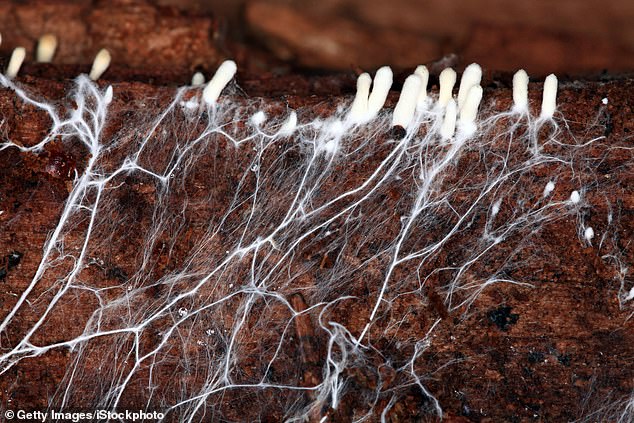
Researchers at Cornell University have developed a system that uses the mycelium of a mushroom (pictured) to control a walking robot
Co-author Professor Rob Shepherd, head of Cornell’s Organic Robotics Lab, said: ‘This paper is the first of many that will use the fungal kingdom to equip robots with environmental sensors and commands to enhance their autonomy.’
When we think of fungi, we may immediately think of mushrooms. However, this is just the tip of the iceberg.
A mushroom is nothing more than the fruiting body of a much larger underground network of hair-like structures called mycelia. These make up the bulk of a fungus’ mass and are among the largest organisms on Earth.
But thanks to their incredible properties, these enormous fiber networks also form a perfect basis for biological robots.
Fungi naturally create electronic signals that travel through ion channels that are very similar to the ion channels in the neurons of the brain.
They can also respond to chemical and biological signals and even to environmental stimuli.
The researchers took advantage of these natural properties to make the mycelium function as a simple brain for the robot.
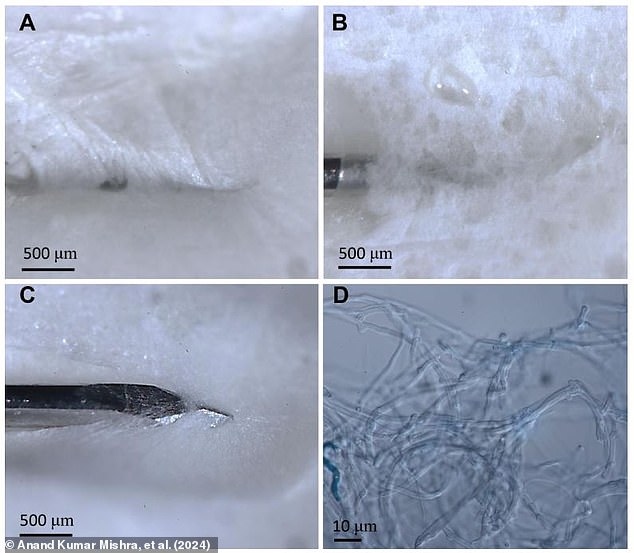
Mycelium is able to produce natural electrical signals and respond to stimuli in the environment. The researchers recorded these signals by growing mycelia around electrodes (see image).
Petri dishes containing mycelium are placed in an interface that blocks all external interference and accurately records natural electrical activity.
This raw signal is processed to detect the rhythmic spikes of the mycelia, which are then converted into a signal that is used to control the robot’s motors.
Because fungi are light-sensitive, bright light causes a change in the electrical activity of the mycelium, which sends commands to the robot.
This allows the mushroom’s natural activity to control the robot and respond to the world around it, even if the fungus is not strictly aware of what it is doing.
Using this system, the researchers created two robots: a soft, starfish-like robot that walks on five legs and a larger robot that uses wheels.
When the fungi were exposed to ultraviolet light, they changed their walking pattern, showing how hybrid robots can respond to stimuli.
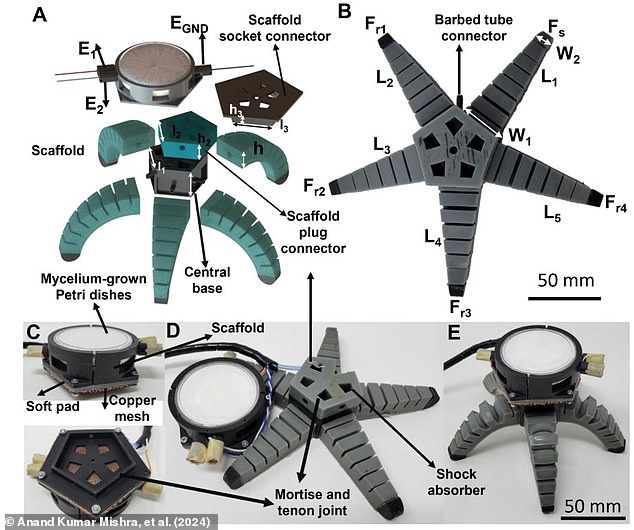
A specialized housing containing a mycelium sample is built into a soft robot that acts as the brain of the walking apparatus
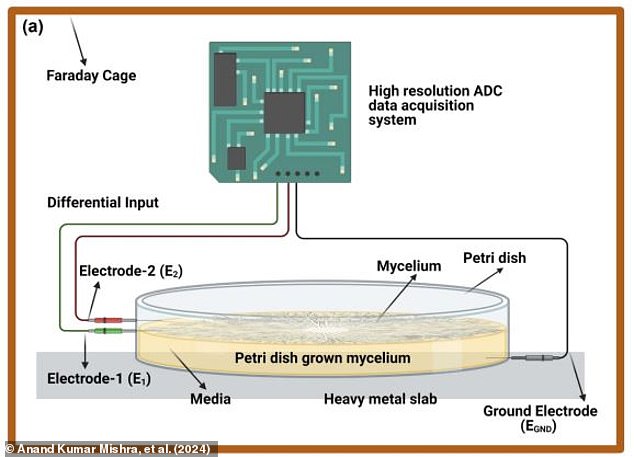
The raw signals from the mycelium (illustrated) are processed to find the natural rhythmic peaks, which are then converted into a control signal for the robot
Professor Shephard says: ‘By growing mycelium inside the electronics of a robot, we could make the biohybrid machine sense and respond to its environment.’
Because mycelium can respond to so many different types of stimuli, the potential applications for this technology are enormous, the team says.
“In this case we used light as the input, but in the future it will be chemical,” said Professor Shephard.
‘The potential of future robots could be to measure soil chemistry in agricultural crops and determine when to add more fertilizer. This could help to reduce the effects of agriculture, such as harmful algal blooms.’
Fungal biohybrids can also accommodate robots in more difficult environments.
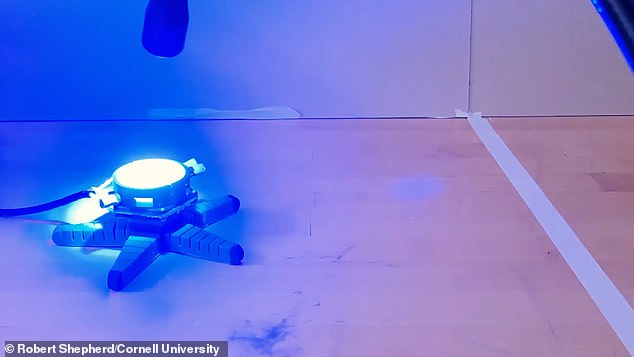
When ultraviolet light is shone on the mycelium, it responds to this stimulus and changes its signals, allowing the mycelium to change the gate of the robot
Lead author Dr Anand Mishra said: ‘Living systems respond to touch, they respond to light, they respond to heat, they even respond to some unknown factors, like signals.
“We can harness these living systems and the robot will respond to any unknown input.”
In the past, scientists have used living cells, such as neurons, to create biological computers that could perform simple tasks, such as playing the video game Pong.
Unlike a Petri dish full of living cells, mycelium is extremely tough and can thrive even under the harshest conditions.
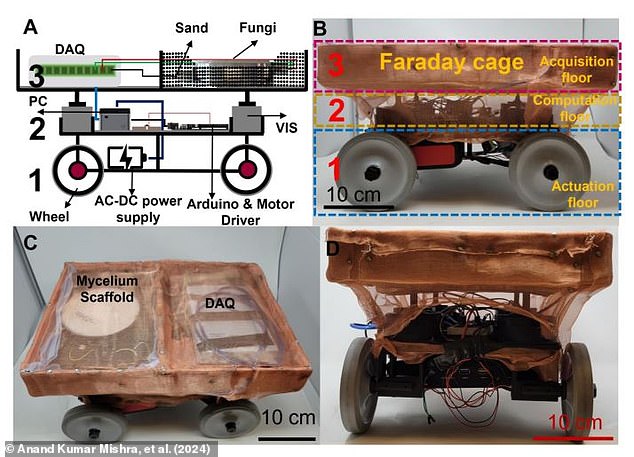
The researchers also created a wheeled robot that uses the mycelium control system to move around and respond to light
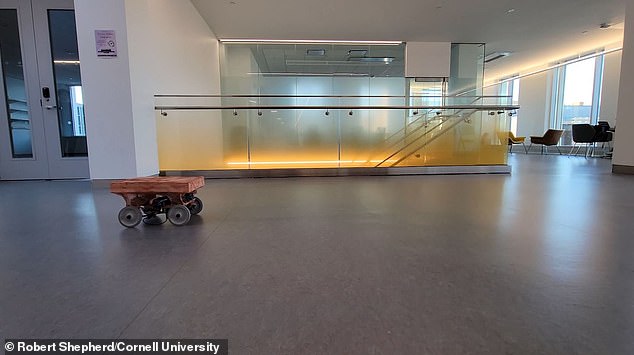
In the future, the researchers say mycelium hybrid robots could be used in more complex environments and gain greater autonomy
According to the researchers, this could make biological robots a practical option for many more environments and situations.
However, Dr. Mishra also believes that the implications of this study extend beyond robotics.
In fact, he says, these kinds of robotic systems can help us understand non-human life at a deeper level.
By giving a fungus a body, we can physically see how it responds to a stimulus or stress, in a way that would otherwise not be possible.
Dr Mishra says: ‘These kinds of projects are not just about controlling a robot, but also about creating a real connection with the living system.’
